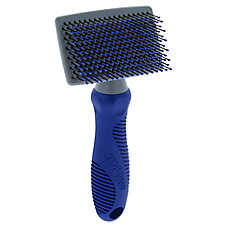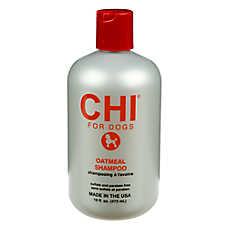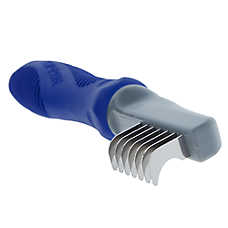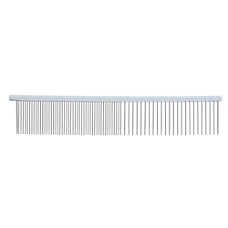Grooming Matted Dog Hair: Expert Tips and Advice
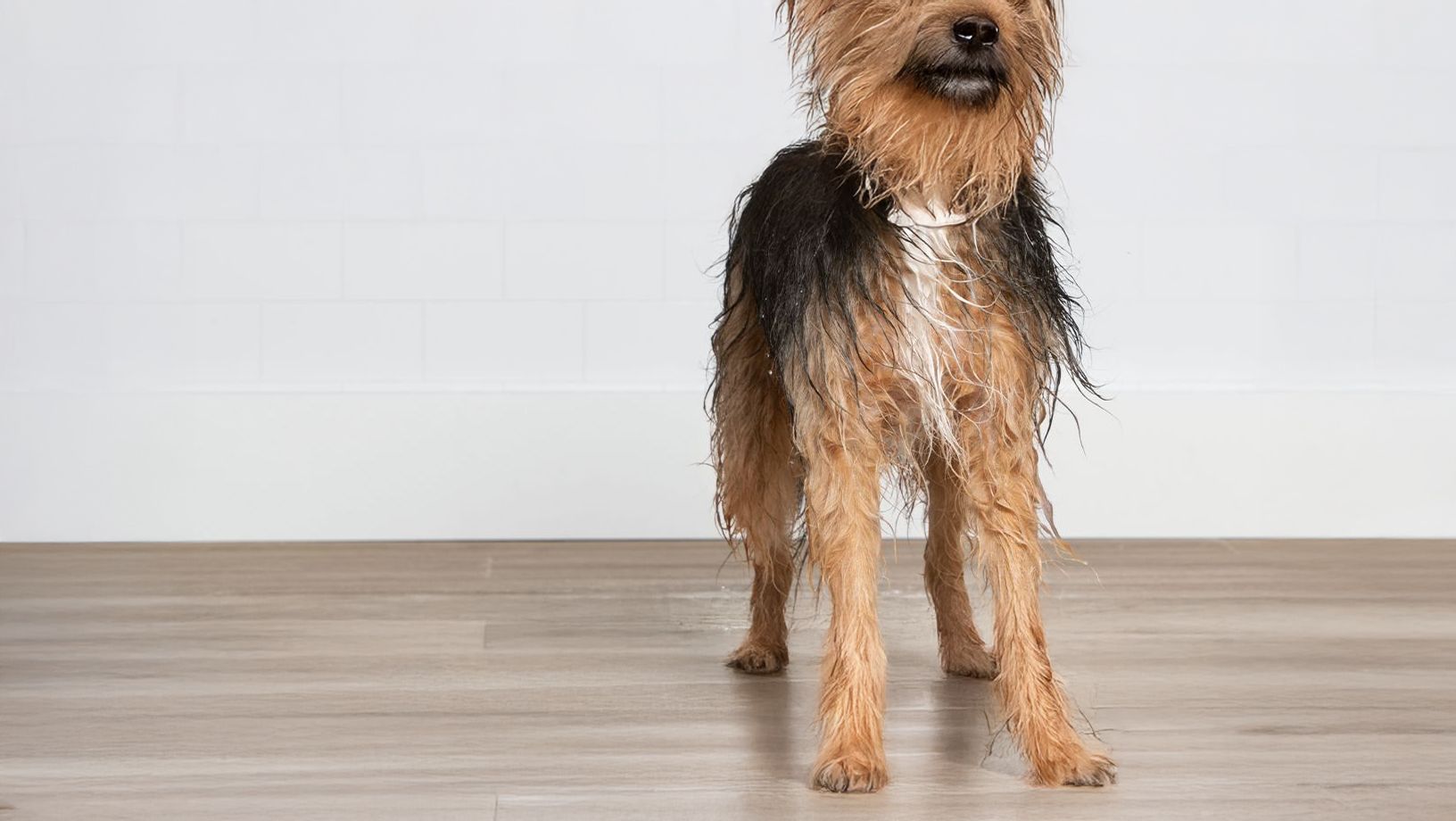
In this Article
- What is Matted Dog Hair & What Causes it?
- Is Matted Dog Hair Painful or Harmful to My Dog’s Health?
- What Dog Breeds are Affected by Mats?
- How do Dog Groomers Handle Matted Hair?
- How to Prevent Matting in Dogs Between Grooms
- How Do I Get My Dog Used to Brushing?
- What Brushes Can I Use to Help Prevent Matting on My Dog?
- What If My Dog Has a Mat That I Can’t Brush Out?
Dogs bring fun and unconditional love into your life, but they also come with responsibilities. In addition to feeding and exercise, pet parents have to look after their pup’s coat and skin, which is very important to a dog’s health.
Think about how often you wash and brush your own hair, how important your cleaning and grooming routine is to prevent tangles and rid your scalp of dead and loose hairs. Well, it’s just as important for your dog.
Whether your dog sheds all over the place or has a low or non-shedding type coat, all dogs need to be brushed often to help prevent tangling and promote healthy skin and hair growth. The main problem you get when you don’t brush your dog’s coat is matting.
What is Matted Dog Hair & What Causes it?
- Mats are clumps of hair that become tangled when left unbrushed.
- There are other factors that may cause these annoying clumps, such as, bathing or swimming without properly drying and brushing afterwards.
- Clothing and accessories can also cause mats; anytime there is something making consistent contact with your dog’s coat. Collars, harnesses, sweaters and jackets or even a cone that’s worn after a trip to the veterinarian sit on your dog’s coat creating friction and rubbing that will very quickly create tangles.
- One other important fact: Puppies, like human babies, are born with very soft, fine hair that eventually sheds while new adult hair grows in. This is a normal process for every dog but is also a very common time to see matting because the soft puppy coat will tangle with the new adult hair. Be sure to introduce your puppy to brushing early on so you can manage their coat through this transitional phase.
Is Matted Dog Hair Painful or Harmful to My Dog’s Health?
- Have you ever had an elastic band around your wrist that was a bit too tight and when you removed it your skin was red and sore? Mats will do the same thing to your dog’s skin. The tighter the mat, the more it pulls, creating discomfort for your pet.
- It’s also important to keep in mind that matting prevents you seeing anything under the cluster of hair, such as, irritated skin or skin conditions, minor wounds or even fleas.
- Matting may also trap feces and urine that if left for too long near the skin will burn and irritate your dog and may make a visit to your vet necessary.
What Dog Breeds are Affected by Mats?
Mats can happen on just about any dog. Here are some of the most common breeds that may be prone to matting.
Drop & Silky Coated Dogs
These dogs will have hair that tends to be on the thinner side, and they don’t usually have an undercoat. Drop & silky coated dogs’ hair resembles human hair in appearance and texture. These dogs include:
- Yorkshire Terriers
- Silky Terriers
- Maltese
Curly Coated Dogs
Curly and wavy coated dogs have a slight undercoat that need to be brushed and combed out to prevent matting. These dogs include:
- Poodles
- Doodles
- Bichon Frises
Wiry Coated Dogs
These tend to be terrier breeds that generally have a harsh textured coat on the outside and a soft undercoat underneath. Usually mats occur because the undercoat has been building up for a long period of time, causing mats. These dogs include:
- West Highland White Terriers
- Carin Terriers
- Schnauzers
- Scottish Terriers
Combination Coated Dogs
These dogs may have a mixture of hair that can be difficult to maintain and lead to mats. These dogs include:
- Golden Retrievers
- Setters
- Australian Shepherds
How do Dog Groomers Handle Matted Hair?
This depends on several factors including how thick the mats are, where they are located, what percentage of your dog is matted and their sensitivity to brushing and grooming. At PetSmart, our Professional Stylists complete a thorough Hands-On Pet Assessment to determine the condition of your dog before we perform any bathing or grooming service. This way our stylists can help point out the degree of matting and recommend solutions.
Light and Isolated Dog Matting Solutions
This is when matting occurs in specific areas on your dog that are high friction zones. For example, armpits, behind the ears and between your dog’s back legs. If your dog is active, these tend to be the first areas that hair rubs together, gets tangled and mats up. If your dog scratches their ears or rubs them on the carpet like mine do, they get matted.
Depending on how tight these mats get or how sensitive your dog is, your groomer may try and brush them out. Because these mats are in sensitive areas, most groomers will take electric dog hair clippers with a very safe blade and do what we call a “spot shave” on the affected areas.
Moderate Dog Matting Solutions
Moderate matting can be tricky; it all comes down to how patient your dog is. In most cases, moderate matting would cover a larger area of the dog and include light, isolated matting. This matting would not be directly on your dog’s skin and a groomer could potentially brush it out gently using a soft slicker brush and a conditioning spray to reduce damage to the hair, so it does not mat right back up.
Not all dogs will tolerate being brushed for 5 minutes, let alone for upwards of an hour. While the brushing process should never be painful, some dogs are more sensitive than others. At PetSmart, your groomer will never push your dog past their comfort level.
Heavy Dog Matting Solutions
When matting covers most or all of a dog, groomers refer to it as a pelted coat. (Think of a sheep that gets sheared; when they are shaved, the matted coat it comes off in pieces.) When you touch a dog with heavy matting, it will feel like the dog is wearing a coat and it can be very difficult to reach their skin. With heavy matting, the only effective and comfortable option is shaving, a safe process in which nearly all coats grow back.
You may ask, “Why can’t the matts be brushed or even cut out?” Brushing them out could take hours and the hair will be so damaged that it will tangle again right away. Using scissors to cut out mats can be very dangerous because it’s impossible to identify where the mat stops and the skin begins. The best and safest option is to use a clipper with a short blade that will safely go underneath the mat, safely removing it from the skin. This process can also be time consuming, so your groomer will exercise patience and remove the mats slowly. They will also recommend a regular grooming routine to prevent future matting.
How to Prevent Matting in Dogs Between Grooms
We know that dogs like to be dogs. They love to find joy in the little things in life like rolling in dirt, splashing in puddles, swimming and playing with you and other dogs. It’s important to remember that these fun activities can also cause matting. As a groomer, I always recommend that any collar, harness or clothing should not be worn all day every day because these items tend to cause matting. It’s always a good idea that after any play time, swim time or removing clothing, you run a brush through your dog’s coat to help avoid any mats forming.
Regardless of what breed of dog you have, it’s important to brush your dog regularly. The frequency depends on what type of dog you have and their activity level. Every dog can benefit from a good brushing at minimum, once per week. I have an English Cocker Spaniel who’s 10 years old, but still very active. I keep him in a traditional cut, which means he has a lot of hair. He tends to get mats in his armpits and between his back legs, but as long as I brush him every two days it helps keep them at bay.
Here are some other tips to help prevent mats between grooms:
- Use a brushing or conditioning spray, which helps prevent static and conditions the hair to help prevent breakage.
- Use shampoo and conditioner made for dogs to bathe your pup once every 4-6 weeks. This helps to keep the hair clean which prevents dirt and oil build up that can cause mats.
How Do I Get My Dog Used to Brushing?
If you brush and maintain your dog’s coat every day, then the process will become quick, easy and pain-free for your pet. But let’s say you have a pup who’s not a fan of brushing. That’s most likely because they have not had a great experience. For both puppies and dogs who are new to brushing, it’s best to start slow, let them sniff or even lick the brush so they know it’s safe and not scary.
The next step is to brush them very lightly and offer a treat when they either don’t react, or they react positively. It’s important to reinforce the good behaviors that you want. I like to use movie night as my time to brush our dogs. This way the family is all sitting down in one area, everyone is relaxed and it’s calm. One by one, I gather my dogs into my lap and let them lay down while I brush them—and most of the time they fall asleep!
What Brushes Can I Use to Help Prevent Matting on My Dog?
There are two main dog dematting tools that will work on any coat that can become matted: A slicker brush is a metal- pinned brush that is specifically designed to be used on dogs and cats and a greyhound comb is a long, thin metal comb. Both the slicker brush and comb should be metal because dog fur can be so dense, if you tried to use plastic these tools would just break. You can find these items at your local PetSmart along with many other great grooming tools.
- Start with the slicker brush. This should be gently used on the whole body brushing away from the skin and in the direction that the coat is growing. Refrain from using this brush close to your dog’s private area, around the eyes and the inside of their ears. The skin in these areas is much too sensitive and you don’t want brushing to cause any injuries.
- Follow up with the greyhound comb. Separate sections of hair and work your comb through from the base of the skin to the tip of the hair. This will help find any of those pesky tangles and remove them before they become unwanted mats. If you come across a tangle, try not to tug at it too much as this will be painful for your pet. Simply take your slicker brush and work the tangle out, brushing in the direction of the hair growth and not against it.
What If My Dog Has a Mat That I Can’t Brush Out?
If mats become too big or cover a large area of your dog, then chances are you cannot brush them out. If this is the case, then the mats will have to be shaved out. At PetSmart Grooming Salons, we use a clipper with the shortest blade as this is the safest way to remove them.
If you choose to try and remove mats at home, we highly suggest you don’t use any kind of scissors or human clippers or beard trimmers to cut them out. Using scissors can actually cause you to cut your dog’s skin because you cannot safely see through or under the mat. Human clippers and beard trimmers are meant for human hair and may not have the strength to get through dog hair. They can also cause clipper burn or irritation because they cut shorter than dog clippers.
If you decide you still want to try this at home, be sure to stop by your local PetSmart, where we carry a variety of dog-specific clippers that you can use at home as well as brushes, combs, de-matting rakes, mat breakers, shampoos and conditioners. Our in-store associates are happy to assist with all your questions.
If you find your dog’s coat is becoming unmanageable, call your groomer to book an appointment. At PetSmart, your safety-certified Stylist will perform a thorough Hands-On Pet Assessment where they will check your dog’s skin, coat, ears, nails and teeth. During this process, they will be able to check the condition of your dog’s coat and explain to you what your grooming options are. Your pet may just need a good brush, maybe a spot shave on a couple of mats or in the most extreme cases, a full body shave. Please remember that shaving down your dog is NOT your groomer's first choice but is often their only option as it is the safest and most sensible way to remove heavy matting.
In this Article
- What is Matted Dog Hair & What Causes it?
- Is Matted Dog Hair Painful or Harmful to My Dog’s Health?
- What Dog Breeds are Affected by Mats?
- How do Dog Groomers Handle Matted Hair?
- How to Prevent Matting in Dogs Between Grooms
- How Do I Get My Dog Used to Brushing?
- What Brushes Can I Use to Help Prevent Matting on My Dog?
- What If My Dog Has a Mat That I Can’t Brush Out?
